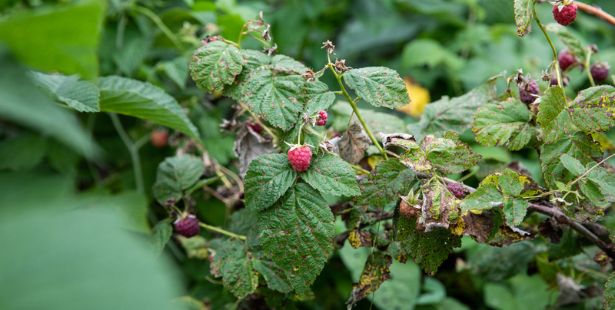Raspberries, what a delight in summer! A delicacy that is all the more within reach, since raspberry bushes are generally easy to grow. Be careful, however, this fruit shrub fears humidity which then promotes the development of certain diseases. One of them is manifested by the appearance of yellow leaves. What to do in this case?
It is also in summer, during the peak raspberry season which extends from June to August, that the first symptoms of a disease causing yellowing of the foliage appear. Symptoms due to the development of l’anthracnose.
Why is my raspberry bush turning yellow and not producing raspberries?
If your raspberry bush has yellow leaves, a yellow tint that appears most of the time at the level of the veins of the foliageit is therefore due to a disease called anthracnose. It is, along with spur blight, one of the most important diseases in raspberries. This pathology, most of the time severe when it appears, also affects the yield of the fruit shrub which then produces significantly fewer raspberries.
In addition, anthracnose also attacks the stems, which then become adorned with small brown spots, but also sometimes the raspberries, which then become grayish and inedible. Thus weakened, plants are much less resistant to heat and cold. The damaged parts can also dry out and fall off. The life span of raspberry plants is reduced and it is high time to act.
Be careful, however, not to confuse anthracnose with another raspberry disease: Septoria leaf spotwhich causes the appearance of round spots with black dots in the center. Anthracnose, on the other hand, causes the formation of spots that are also round (2 to 3 mm), but whose center is light with a dark margin. Symptoms due to the presence of a fungus: Elsinoe veneta.
In infected raspberries, anthracnose can also be confused with tarnished bedbug bitesor other damage caused by rain or wind. To diagnose the presence of the fungus Elsinoe veneta on your raspberry bushes, it is better to also rely on the appearance of the foliage and stems. How to treat a raspberry plant with anthracnosea disease that can also affect cherry trees, but also tomatoes, vines and even gooseberry bushes?
Treating a raspberry bush against anthracnose: natural treatments and advice
It is necessary to act as soon as possible to treat a raspberry bush affected by anthracnose, because the treatments are more preventive than curative. To prevent the fungus Elsinoe veneta does not wreak havoc on your raspberry bush, Immediately remove any leaves that start to turn yellow. and do not reuse them to mulch the feet of your raspberry bushes or any other plant, since they are contaminated. It is better to get rid of them permanently by burning them.
Yes the mushrooms Elsinoe veneta had time to win your whole raspberry bush, remove all damaged parts in the same way. Once the plant has been cleared of infected parts, spray with a treatment based on Bordeaux mixture.
Caution: It is best to treat raspberry bushes in late winter or early spring, avoiding periods of frost or extreme heat, as the product could lose its effectiveness. In addition, such periods already weaken the plants.
Another possible treatment: horsetail manure diluted to 10% in spray. Treat your raspberry bushes every 10 days or so in spring, until the end of August. At the start of an attack, horsetail manure can even act as a curative treatment and not just a preventative one. Garlic in oily maceration or decoction can also act as a fungicide for raspberry plants.

Be careful when watering raspberry bushes
Also keep in mind that Anthracnose is a disease favored by excessive humidity.which, combined with high temperatures, can cause damage. Summer storms are then conducive to the development of this pathology. The fungus Elsinoe veneta also spreads through watering water, which can splash other plant parts, but also through hoeing and pruning tools. Garden helpers (insects, birds, etc.) also contribute to this spread. It is therefore necessary to adopt good raspberry bush maintenance and watering habits.
Tips to limit the spread of anthracnose : make sure to water well at the foot of your raspberry bushes, without splashing the other parts. Similarly, do not go between the rows after watering or a downpour, so as not to spread the fungus Elsinoe veneta to other plants. Thoroughly disinfect the tools you used to prune shrubs or hoe the soil around them.
Finally, know that The fungus can remain active for almost two years in plant debris or in the soil.. This is why you should not collect and reuse leaves or soil around infected plants and do not use seeds from plants affected by anthracnose. In the vegetable garden, practicing crop rotation and spacing out rows sufficiently also helps limit the spread of this type of disease.
Article updated
consoGlobe also recommends…
Source: www.consoglobe.com


